Eurocom P5 Pro / Clevo P750ZM Review: True DTR
by Jarred Walton on March 10, 2015 10:00 AM ESTClevo P750ZM General Performance
General performance on high-end notebooks and laptops doesn’t usually add much to the performance story, but in this case we’re actually able to see what happens when we pit the fastest current mainstream desktop CPU against other mobile solutions. I’d love to have numbers from the i7-4860HQ as well as the i7-4710HQ, as that would obviously close the gap, but given the i7-4790K is priced roughly the same as an i7-4710HQ/4710MQ, you should get more bang for the buck.
Here’s a look at our standard CPU and system benchmarks, along with 3DMark for reference; WiFi performance is also included near the bottom of the page. Note that the MSI GT70 and GE60 were both equipped with hard drives for storage, so that will affect some of the PCMark results in particular.
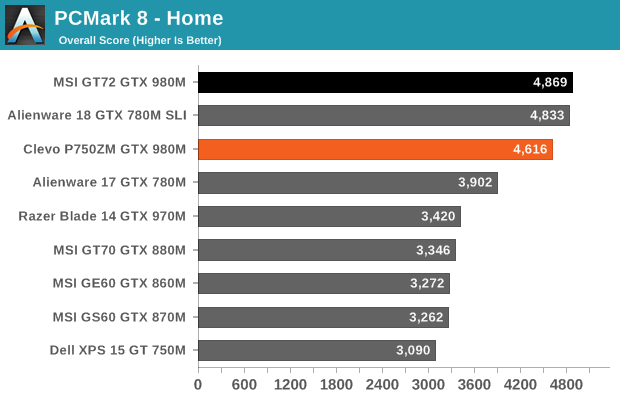

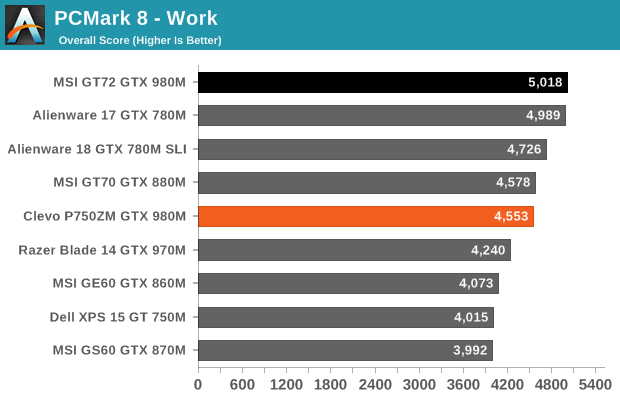
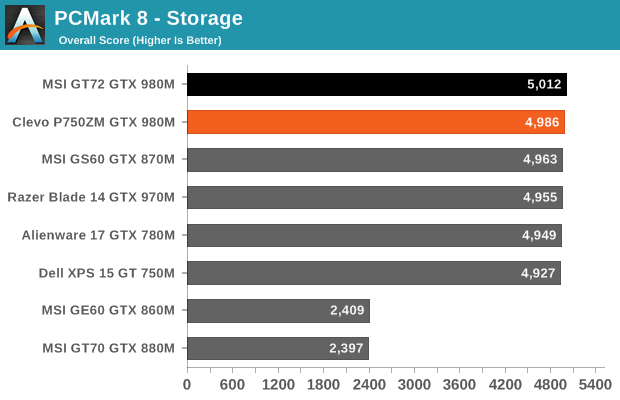
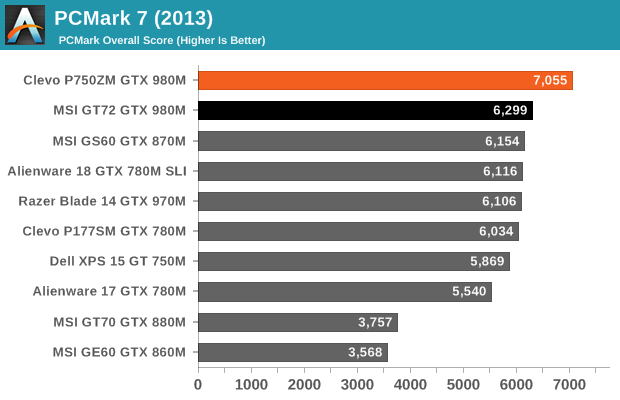


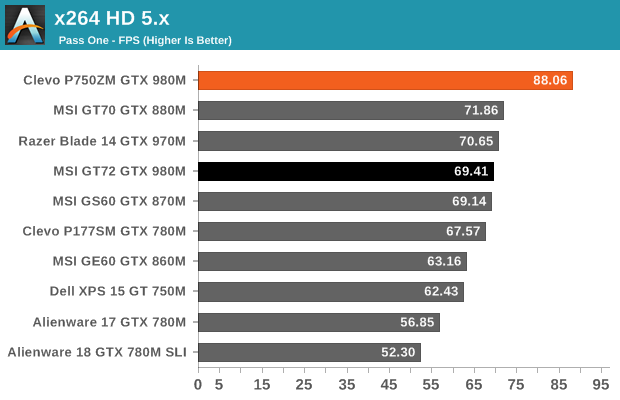
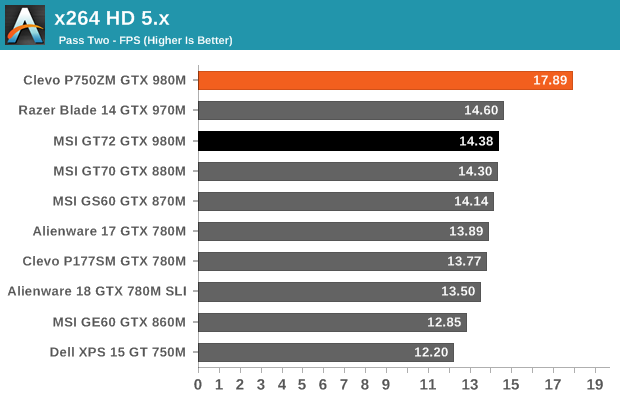
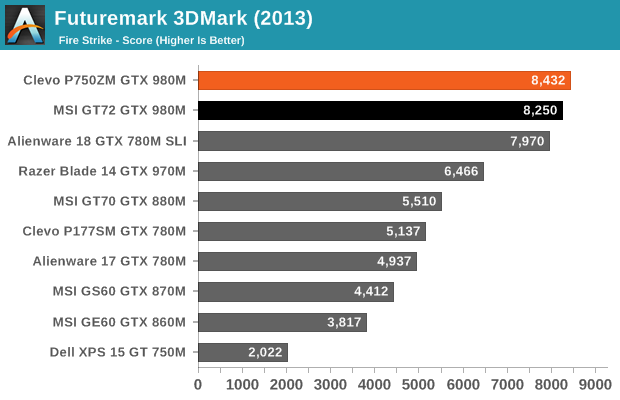
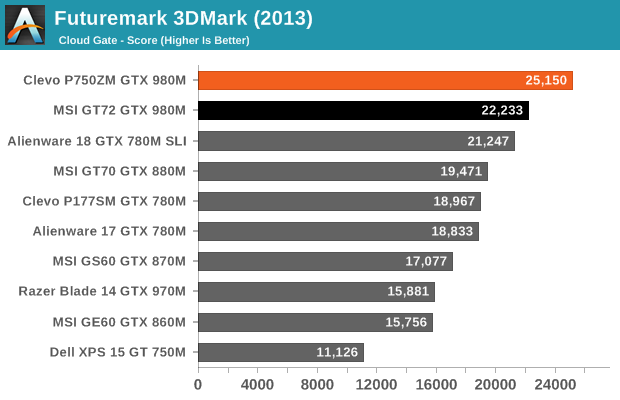
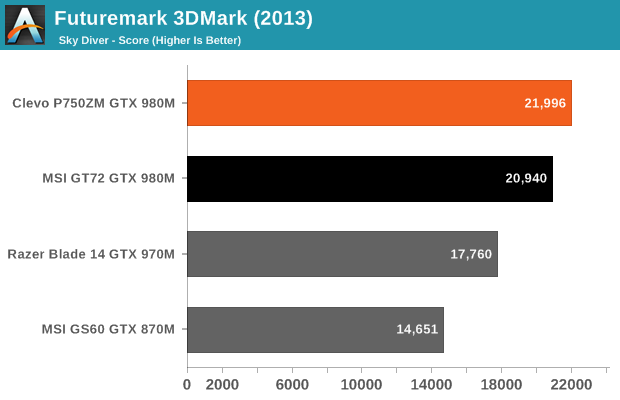
There are no surprises here: the P750ZM with a Core i7-4790K is basically the fastest notebook we’ve tested. A hex-core or octal-core LGA2011 chip could win out in multi-threaded scenarios, but that’s not really going to push gaming performance any higher, and even mobile workstations may not really need more than four cores. There are individual tests where the P750ZM doesn’t place first, but those are often influenced by other factors – e.g. faster quad-RAID SSD storage or access to Intel’s Quick Sync. When we get to CPU-centric testing, however, there’s no competition from the mobile parts; Cinebench and x264 encoding show a solid 20-25% improvement in performance over the next fastest processor.
Interestingly, in 3DMark we again see the combination of desktop CPU with GTX 980M typically outperforms the 780M SLI setup in the Alienware 18. SLI puts a heavier load on the CPU to begin with, so it makes sense that the Kepler mobile parts in SLI are unable to keep up. SLI GTX 980M would obviously change things, but we haven’t had such a system in for testing yet.
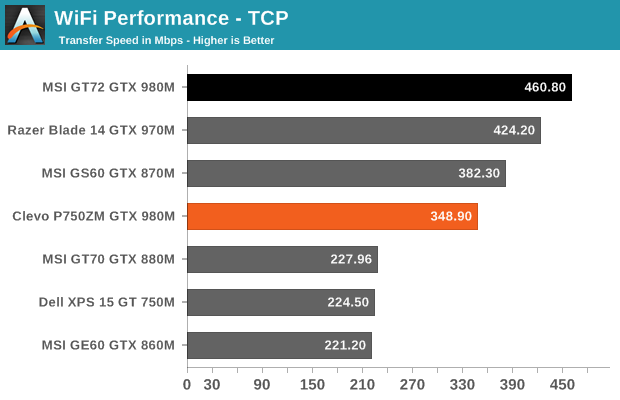
As for wireless performance, the dual-band Killer 1525 802.11ac solution worked fine during testing. We’re still not at the point where WiFi can actually outperform GbE, but for short distances we’re at least getting closer. It’s also worth mentioning that WiFi testing can be highly variable, even in the same location. Both the MSI GT72 and P750ZM used the same WiFi adapter, so either there are differences in the antenna that caused a drop in throughput or else the change in environmental conditions had an impact. This is another reason wired connections are often still desirable.










74 Comments
View All Comments
JarredWalton - Tuesday, March 10, 2015 - link
Correct I believe: AFAIK, NVIDIA requires a mobile chipset to enable Optimus. I don't think there's any technical reason why they couldn't do it on a desktop chipset, but then even if it was supported Clevo likely wouldn't have enabled this as it's a high-end notebook.boeush - Tuesday, March 10, 2015 - link
I must be going crazy... but why is it nobody asks or comments about availability of screens with a non-16x9 aspect ratio?? A machine claiming to be DESKTOP REPLACEMENT should be usable for more then movie watching. How the hell is one supposed to work on documents or do any serious coding where the VERTICAL real live state is far more valuable than horizontal? Where are 2560x1600 matte 17-18" screens??? Is nobody making them? Is there no demand - am I the only lunatic who dreams of them year after year as if they were some unachievable sci-fi fantasy?boeush - Tuesday, March 10, 2015 - link
*sigh* pardon the stupid typos brought to you courtesy of auto-incorrect on my smartphone... You get the gist though, I hope...chlamchowder - Tuesday, March 10, 2015 - link
The Surface Pro 3 has a 3:2 screen.Yeah, I don't get what's up with the "shortscreen" format. Maybe people just really like scrolling. I miss my first laptop, which had a 4:3 screen.
boeush - Tuesday, March 10, 2015 - link
Unfortunately, Surface Pro 3 isn't what I'd call "desktop replacement". When it comes to the latter, for me at least, anything less than 17" is a joke. On DTR machines I expect a large high-res screen, and a full-size keyboard (not a reused one originally designed for a 15.6" form factor.) Man, I'd KILL for a 4:3 screen on a DTR laptop. But at least 16:10 is the minimum for me; that's where I draw the line. It's why I still haven't upgraded from my ancient DELL M6400: all the newer machines (even ones styled as "mobile workstations"!!) are hopelessly mired in the 16:9 nightmare...Notmyusualid - Wednesday, March 11, 2015 - link
^ Kind of sums up the situation for me too.kgh00007 - Tuesday, March 10, 2015 - link
Nice review! Is there any chance you are going to ger in the 2015 Alienware 15 for review?D2ultima - Wednesday, March 11, 2015 - link
Glad to see a really nice review of one of these machines that reviews it for the capacity it's designed for, and not just complain about its size or aesthetics. Thanks very much for this Anandtech *gives thumbs up*mrcaffeinex - Wednesday, March 11, 2015 - link
Since they squeezed a desktop i7 (88W TDP) and a dedicated mobile GPU into one of these things, I am curious if it would be possible for someone to squeeze something like the AMD A10-7800 APU (65W TDP) into a notebook chassis. I would think it could be done, and at a price point that would make it appealing too. Any thoughts?JarredWalton - Wednesday, March 11, 2015 - link
It's possible to do it, sure, but the question is whether it's actually worth doing? If you just want a reasonably fast processor, Intel has plenty of mobile parts that can likely match the A10 desktop parts for performance while using less power.In single-threaded performance, any Core i5 mobile part can beat the A10-7850K. For multi-threaded workloads, the A10-7850K might be a bit faster than a Core i5-4330m, but if so not by much. So you have a higher power APU that will require better cooling and end up delivering less performance. Sure, Graphics is faster than the Intel GPU, but that's not saying much.